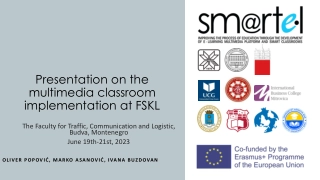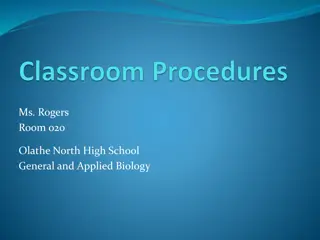Influence of Classroom Climate on Student Goal Structures in High-School Biology Classrooms
Classroom climate plays a crucial role in shaping students' goal structures and learning outcomes. Research indicates that classrooms high in cooperation and cohesion lead to positive behaviors, improved academic performance, and favorable attitudes among students. The study also reveals that different subjects may exhibit varying classroom climates, which could be attributed to teachers' teaching styles. Understanding how classroom environments influence student goal orientations can help educators create conducive learning atmospheres that promote mastery orientation and positive motivation in students.
- Classroom climate
- Student goal structures
- High-school biology
- Academic achievement
- Learning environment
Download Presentation

Please find below an Image/Link to download the presentation.
The content on the website is provided AS IS for your information and personal use only. It may not be sold, licensed, or shared on other websites without obtaining consent from the author. Download presentation by click this link. If you encounter any issues during the download, it is possible that the publisher has removed the file from their server.
E N D
Presentation Transcript
Classroom Climate and Students Goal Structures in High-School Biology Classrooms in Kenya Winnie Mucherah Ball State University Muncie, Indiana, USA June, 2015
Classroom climate and student learning Typically, teachers concentrate almost exclusively on the assessment of academic achievement and devote little attention to factors which might be related to their students patterns of adaptive learning and performance p. 63
Background on Classroom Climate Does a classroom s environment affect student learning and goal structures? Can teachers conveniently assess the climates of their own classrooms? Do teachers and their students perceive the same classroom environments similarly? Do students of different goal structures, grade levels or genders perceive the same classroom differently?
Prior Research Classroom climates that are high in cooperation and cohesion: Reduction of inappropriate behaviour Increased attendance Reduction in the number of assignments not completed Academic improvement Positive attitudes Perceptions of fairness of grading
Prior Research Classroom climate differ by subject matter Science classrooms (mixed findings): High in competition, low in affiliation Low in cooperation and cohesion Social studies classrooms: High in affiliation, low in competition Diversity in science classrooms-could be due to teacher s teaching style
Influence of classroom climate on student goal structures and learning outcomes The goal structures of classrooms influence whether students pursue learning goals (mastery orientation) or performance goals (ego orientation). Classroom environments high on task involvement and innovation: students with learning goal orientations HOWEVER - classroom environments high on competition had students with performance goal orientations (Patrick et al. 2003) Students who have learning goals are more likely to maintain positive motivation in school (Anderman et al. 2002; Kaplan et al. 2002; Urdan et al. 1998).
Goal Orientations (Dweck & Legget, 1988) Mastery goals: focus on mastering tasks and increasing competence at different tasks (e.g., how can I do this task? What will I learn?) Performance goals: seek to maximize favorable evaluations of their ability and minimize negative evaluations of ability (e.g., Will I look bright? Can I beat others?)
Research questions 1. What is the classroom climate in biology classrooms? 2. Are there school and grade-level differences in students perceptions of their classroom climate? 3. What classroom climate factors predict student goal structures? 4. Do students, teachers and observers perceive the classroom climate and goal structures similarly?
Design Participants Form 2 and 3 Ages 15 and 16 1 male boarding school (n=490) 1 female boarding school (n=401) 12 teachers Quantitative + Qualitative Student questionnaires Teacher questionnaires Classroom observations
Measures: STUDENTS Classroom Climate Questionnaire (Trickett & Moss, 1974, 1995) Involvement Affiliation Teacher Support Task Orientation Competition Order and Organization Rule Clarity Rule Strictness Innovation Patterns of Adaptive Learning Mastery Goals Performance Approach Goals Performance Avoidance Goals
Measures: TEACHERS & OBSERVERS Teacher Classroom Climate Questionnaire (Trickett & Moss, 1974, 1995) & Patterns of adaptive learning scale (Midgley et al., 1996b, 2000) Similar to student version Classroom observations 2 Observation forms (climate & goals) Inter-rater reliability (.95)
Construct Validity Prior to the visit, the 2 surveys were sent to two volunteer teachers from each school to examine validity of items Recruited via e-mail Identified 2 terms: smart & dumb which were later replaced by bright and stupid These teachers did not participate in the study to control for possible biases
ANALYSIS MANOVA: Independent Variables: School Form Dependent Variables All measures
RESULTS for Classroom Climate Significant difference between schools: Schools 1 and 2 differed on all the classroom climate variables except Teacher Support and Competition Significant difference between grades: Form 3 perceived significantly more Teacher support, Task focus, Competition, and Rule strictness.
RESULTS for Learning Goals Male boarding school(1) reported: Significantly higher personal performance-approach goals Teachers encouraging performance approach goals and performance avoidance goals Female boarding school: Teachers encouraging mastery goals
What classroom climate factors predict student goal structures? STUDENTS GOALS Teacher Support and Order and Organization predicted personal mastery goals Task Focus and Innovation predicted personal performance approach goals Competition and Rule Strictness predicted personal performance avoidance goals
What classroom climate factors predict student goal structures? PERCEIVED TEACHERS GOALS Affiliation, Teacher Support, Rule Clarity, and Innovation predicted perceived teacher mastery goals Involvement, Teacher support, Task Focus, Competition, Order and Organization, and Rule Clarity predicted perceived teacher performance approach goals. Competition and Rule Strictness predicted perceived teacher performance-avoidance goals
What classroom climate factors predict student goal structures? CLASSROOM GOALS Affiliation was the only significant predictor for classroom mastery goal structures Affiliation and Competition predicted classroom performance approach goals Competition and Rule Strictness predicted classroom avoidance goals
Do teachers and students perceive the classroom climate similarly? Teachers generally viewed their classroom climates more positively Teachers and students differed on the classroom climate aspects of Teacher support Task focus Innovation
What are teachers perceptions of their classroom and school goal structures? Teachers more frequently reported a school structured performance- approach and mastery goals than classroom structured goals, but no statistical difference.
Classroom Observations CLIMATE Classroom climates were conducive to high student involvement and had supportive teachers Students interacted positively with each other Classroom activities and tasks were low in innovation Clear rules and strict in enforcing these rules No significant differences between the teachers, classes or schools
Classroom Observations GOAL STRUCTURES Teachers stayed on task and checked to see if students understood Few incidences where students worked in collaborative groups No significant differences between the teachers, classes and schools
Discussion Classroom climate similar in teacher support and competition Grade differences: form 3 high on: Involvement, task focus & competition School/Gender differences: Males- more performance approach goals Difference between student and teacher perceptions on climate
Discussion Teachers and observers revealed positive classroom environments that are high on task focus and high performance-approach goal structures at the personal, classroom and school levels. Cross-cultural differences: contrary to past research, there was high affiliation & performance goals Importance of cross-cultural studies
Limitations Teacher sample size-small, not representative of biology teachers in Kenya Only 4 teachers involved in validity check Reliabilities for the classroom climate scales were relatively low (could be due to difference in meaning making of some of the items-cultural difference?)
Conclusion Goals: Mastery vs Performance Given that the definition of a mastery goal structure centers on learning, understanding and improvement, it is likely that culturally valued activities that reflect this goal are necessary, if not sufficient, for the creation of a meaningful goal structure which, in this study, involves performance approach goals p. 78























